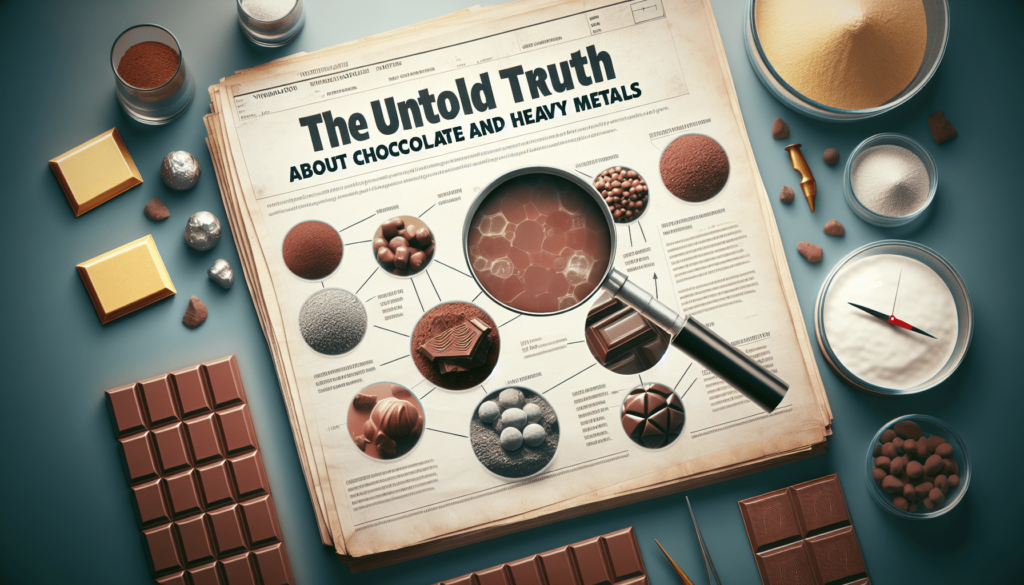Hey there! Ever wondered which chocolate has the least amount of heavy metals? Well, we’ve got the inside scoop for you. In this article, we’ll explore the fascinating world of chocolate and uncover which types are the safest when it comes to heavy metal contamination. So grab a snack and get ready to indulge in the delicious realm of low heavy metal chocolate options. It’s time to satisfy your curiosity while satisfying your sweet tooth!
Cocoa Bean Origins
Geographical Influence on Heavy Metal Levels
When it comes to cocoa bean origins, the geographical location where the beans are grown plays a significant role in the levels of heavy metals they may contain. Factors such as soil composition, climate, and proximity to industrial areas can all affect heavy metal levels in cocoa beans.
In regions where the soil is naturally rich in heavy metals, such as lead or cadmium, there is a higher chance that these metals will be absorbed by the cocoa trees and ultimately present in the beans. This is of particular concern in areas where mining activities or industries emitting heavy metals are prevalent.
Conversely, cocoa beans grown in regions with well-drained, fertile soils and limited exposure to heavy metal contaminants tend to have lower levels of heavy metals. These regions are often characterized by a favorable climate, such as tropical or equatorial regions, which are ideal for cocoa tree cultivation.
Organic vs. Non-Organic Cocoa Beans
Apart from geographical factors, the methods used in cocoa bean cultivation also play a role in heavy metal levels. Organic cocoa beans, grown without the use of synthetic pesticides, fertilizers, or genetically modified organisms (GMOs), are generally considered to have lower levels of heavy metals.
Non-organic cocoa beans, on the other hand, may contain residues of synthetic pesticides and fertilizers, which can contribute to higher levels of heavy metals. These chemicals may accumulate in the soil over time and be absorbed by the cocoa trees, leading to elevated heavy metal levels in the beans.
Opting for organic cocoa beans not only reduces the risk of heavy metal exposure but also supports environmentally-friendly farming practices. By choosing organic chocolate, you can enjoy a treat that is not only safer but also more sustainable.
Processing Methods
Impact on Heavy Metal Levels
The processing methods used in the production of chocolate can also influence the levels of heavy metals present. From roasting and fermentation to conching and grinding, each step can impact the final heavy metal content.
Roasting and Fermentation
Roasting and fermentation are crucial steps in chocolate production that impact both the flavor and heavy metal levels. During roasting, the cocoa beans are subjected to high temperatures, which can potentially reduce heavy metal levels by evaporating or breaking down some of the contaminants.
Fermentation, a process that usually occurs after harvesting, involves the natural fermentation of cocoa beans in banana leaf-lined piles or fermentation boxes. This step enhances the flavor and aroma of the chocolate but can also contribute to heavy metal reduction by promoting the breakdown and elimination of some contaminants.
Conching and Grinding
Conching, a process involving the mixing and refining of chocolate for an extended period, and grinding, which transforms roasted cocoa beans into a fine paste, have limited influence on heavy metal levels. These processes primarily focus on developing the smooth texture and intense flavor of the chocolate, rather than reducing heavy metal content.
While the impact of processing methods on heavy metal levels is not as significant as other factors like geographical influences or bean cultivation methods, it is still important to consider the overall production process when evaluating the heavy metal content of chocolate.

Cocoa Powder Production
Impact on Heavy Metal Levels
Cocoa powder, a commonly used ingredient in baking and cooking, can also contain varying levels of heavy metals. The production process for cocoa powder involves multiple steps, including drying, roasting, and grinding, which can all influence heavy metal concentrations.
Natural vs. Dutch-Processed Cocoa Powder
Natural cocoa powder is produced by separating the cocoa solids from the cocoa butter, resulting in a powder with a slightly acidic taste. It is generally considered to have lower heavy metal levels compared to Dutch-processed cocoa powder.
Dutch-processed cocoa powder, on the other hand, undergoes an additional processing step called alkalization. This process neutralizes the natural acidity of cocoa and results in a darker color and milder taste. However, some alkalization methods may introduce contaminants and potentially elevate heavy metal levels.
When choosing cocoa powder, opting for natural varieties is generally recommended to minimize heavy metal exposure. Natural cocoa powder not only offers a distinct and slightly acidic flavor profile but also provides peace of mind in terms of heavy metal content.
Cocoa Butter Extraction
Impact on Heavy Metal Levels
Cocoa butter, the fat extracted from cocoa beans, is a versatile ingredient used in various chocolate products and cosmetics. The method of extracting cocoa butter can potentially influence heavy metal levels.
Cold-Pressed vs. Solvent Extraction
Cold-pressed cocoa butter extraction involves a mechanical process that gently presses the cocoa beans to extract the fat. This method generally yields cocoa butter with lower heavy metal levels since it does not involve the use of chemical solvents.
Solvent extraction, on the other hand, involves the use of chemical solvents, such as hexane, to efficiently extract cocoa butter. While this method can result in a higher yield of cocoa butter, it may also introduce contaminants and contribute to elevated heavy metal levels.
Choosing products that explicitly mention cold-pressed cocoa butter extraction can help ensure lower heavy metal levels in the chocolate you consume or use in your skincare routine.

Milk Chocolate
Presence of Heavy Metals in Milk
Milk, an essential ingredient in milk chocolate, can potentially introduce heavy metals into the final product. The presence of heavy metals in milk primarily depends on the source of the milk and the farming practices employed.
Cows that graze on pastures with contaminated soils may ingest heavy metals, which can then accumulate in their tissues and milk. Additionally, the use of certain fertilizers and additives in livestock feed can also contribute to higher heavy metal levels in milk.
Impact on Heavy Metal Levels
While milk chocolate can contain heavy metals due to the presence of milk, the overall impact on heavy metal levels may vary. The heavy metal content in milk is influenced by various factors, including the region where the milk is sourced, the farming practices employed, and the quality control measures in place.
To minimize heavy metal exposure, choosing milk chocolate from reputable brands that prioritize quality control and source milk from clean and well-regulated dairy farms is advisable. Additionally, considering certifications and testing (discussed later in this article) can further help ensure lower heavy metal levels in milk chocolate.
Dark Chocolate
Cacao Percentage and Heavy Metal Levels
Dark chocolate, known for its intense flavor profile, can vary in terms of cacao percentage. The cacao percentage refers to the proportion of cocoa solids and cocoa butter in the chocolate, excluding any added sugars or milk.
In general, dark chocolates with higher cacao percentages tend to have lower heavy metal levels. This is because higher percentages of cocoa solids result in a smaller proportion of other ingredients, such as sugar or milk, which may introduce heavy metals.
When choosing dark chocolate, look for higher cacao percentages, typically above 70%, to ensure a lower heavy metal content. Not only does high-percentage dark chocolate offer a more robust and less sweet flavor, but it also provides a healthier option with reduced heavy metal exposure.
White Chocolate
Absence of Cacao Solids
Unlike dark or milk chocolate, white chocolate does not contain cocoa solids. It consists mainly of cocoa butter, sugar, and milk solids. As a result, heavy metal levels in white chocolate are primarily influenced by factors such as the source and quality of the cocoa butter and milk solids.
Heavy Metal Levels in White Chocolate
While white chocolate may have relatively lower levels of heavy metals compared to dark or milk chocolate, it is essential to consider the sourcing and processing of the cocoa butter and milk solids. Opting for white chocolate made from high-quality ingredients and choosing reputable brands can help ensure reduced heavy metal levels.
Certifications and Testing
Organic Certification
Choosing chocolate with organic certification can provide assurance that the cocoa beans used were grown without synthetic pesticides or fertilizers. Organic certification ensures that strict farming practices are followed, which minimizes the risk of heavy metal contamination in cocoa beans.
Fair Trade Certification
Fair trade certification verifies that the chocolate manufacturer adheres to specific principles, ensuring fair payment and good working conditions for cocoa farmers. While not directly related to heavy metal levels, fair trade practices contribute to sustainable cocoa farming, which can indirectly impact the overall quality and safety of the chocolate.
Third-Party Testing for Heavy Metal Levels
Some chocolate brands go the extra mile to ensure the safety and quality of their products by conducting third-party testing for heavy metal levels. These tests provide an additional layer of assurance that the chocolate you consume meets stringent quality standards and contains lower levels of heavy metals.
Consumer Tips
Reading Labels for Origin and Certifications
When purchasing chocolate, take the time to read the labels. Look for information on the origin of the cocoa beans and any certifications the product may have, such as organic or fair trade. This information can give you valuable insights into the quality and safety of the chocolate you are buying.
Choosing Organic and Fair Trade Chocolate
To minimize heavy metal exposure and support sustainable practices, consider choosing organic and fair trade chocolate. Organic chocolate ensures that the cocoa beans were grown without synthetic pesticides or fertilizers, while fair trade certification promotes fair compensation and working conditions for cocoa farmers.
By opting for organic and fair trade chocolate, you not only make a healthier choice for yourself but also contribute to a more sustainable and ethical cocoa industry.
Conclusion
When it comes to choosing low heavy metal chocolate, several factors come into play. The geographical origin of cocoa beans, the cultivation methods employed, processing techniques, presence of milk or cocoa solids, and certifications all contribute to the heavy metal content of chocolate.
To minimize heavy metal exposure, consider opting for chocolate made from cocoa beans grown in regions with low heavy metal contamination and processed using methods that reduce heavy metal concentrations. Additionally, choosing higher cacao percentage dark chocolate, reading labels for origin and certifications, and selecting organic and fair trade options can further enhance your chocolate-consuming experience.
By taking these considerations into account, you can savor your favorite chocolate treats with the knowledge that you are making a conscious choice for both your health and the well-being of cocoa farmers and the environment.





